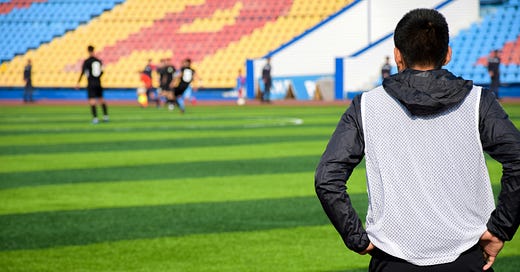BY WAYNE GOLDSMITH
Copyright Wayne Goldsmith - All Rights Reserved
Three Key Concepts:
Traditional coaching creates dependency; great coaching creates independence
The best coaches teach athletes to coach themselves
Leadership through subtle influence is more powerful than instruction
IMAGE - UNSPLASH
I'm going to tell you something that will challenge everything you think you know about coaching: the best coaches I've ever worked with, often, don't actually coach.
They don't stand on sidelines shouting instructions. They don't micromanage every movement. They don't create elaborate systems that require constant supervision.
Instead, they do something far more powerful: they create environments where athletes coach themselves.
The Coaching Paradox
There's a paradox at the heart of great coaching that most coaches never grasp: the more you coach, the less coachable your athletes become.
Think about it. Every time you provide an answer, you rob an athlete of the opportunity to find it themselves. Every time you solve their problem, you prevent them from developing problem-solving skills. Every time you tell them what to do, you reinforce their dependence on external direction.
I learned this lesson many years ago from watching an indigenous Australian Rules Football (AFL) player who was one of the most influential leaders I've ever encountered. While other leaders gave speeches and held meetings, he would quietly take players aside for one-on-one conversations.
He never told them what to do. Instead, he asked questions that helped them discover what they needed to do. He didn't coach them—he coached them to coach themselves.
The Art of Subtle Influence
The best coaches understand that real leadership happens through subtle influence, not direct instruction. They master what I call "leading without leading."
Watch these coaches in action and you'll notice something remarkable: their athletes make better decisions when the coach isn't even there. Why? Because these coaches have taught their athletes to take responsibility and ownership for good decision-making rather than rely on external guidance.
A volleyball coach I worked with completely transformed her approach after embracing this philosophy. Instead of calling every play, she started asking her players: "What do you see? What are your options? What feels right?"
"Initially, they struggled because they were used to being told what to do," she told me. "But within a few weeks, they were making decisions on court that were better than anything I could have called from the sideline."
The Power of Questions
Here's a radical idea: what if instead of having all the answers, coaches became masters of asking powerful questions?
Instead of saying "Run faster," ask "What needs to change for you to run faster?"
Instead of saying "Focus," ask "What are you focusing on right now?"
Instead of saying "You need to be more confident," ask "What would confidence look like for you?"
Questions create ownership. Statements create compliance.
Questions develop thinking. Statements develop dependency.
Questions build problem-solvers. Statements build followers.
The Independence Paradox
Here's what seems counterintuitive but is absolutely true: the more independent you make your athletes, the more they'll value your guidance.
When athletes know they can think for themselves, they start seeking your input not because they need it, but because they want it. The relationship shifts from dependence to partnership.
A swimming coach shared this insight with me: "When I stopped telling my swimmers what to think about during their races and started helping them discover what worked for them, everything changed. Now they come to me with insights about their own performance that I never would have thought of."
Creating Self-Coaching Athletes
The goal of great coaching isn't to create athletes who need you. It's to create athletes who choose you because they value what you bring to their development.
Here's how the best coaches create self-coaching athletes:
They teach principles, not prescriptions. Instead of giving specific instructions for every situation, they teach underlying principles that athletes can apply independently.
They create thinking environments. They design practices that require decision-making, problem-solving, and self-evaluation.
They celebrate independence. When athletes figure something out for themselves, these coaches celebrate it more than when athletes follow instructions perfectly.
They ask "What do you think?" constantly. They genuinely value athlete input and use it to shape their coaching approach.
The Coaching Evolution
This approach requires coaches to evolve from instructors to facilitators, from directors to guides, from answer-givers to question-askers.
It's more challenging than traditional coaching because it requires patience, trust, and a willingness to let athletes fail and learn from failure.
But the results are transformational. Athletes develop resilience, creativity, and ownership that no amount of instruction could create.
The Ultimate Coaching Success
The ultimate measure of coaching success isn't how well athletes perform when you're there. It's how well they perform when you're not.
The best coaches create athletes who:
Make great decisions under pressure
Solve problems independently
Continue improving after they leave the program
Become coaches and leaders themselves
This is what I mean when I say the best coaches don't coach. They do something far more valuable: they teach others to coach themselves.
Your Coaching Challenge
Tomorrow, try this experiment: in every interaction with your athletes, ask at least one question before giving any instruction.
"What did you notice about that?"
"What felt different?"
"What would you like to try?"
Watch what happens when you shift from being the answer-provider to being the question-asker.
You might discover that the best coaching happens when you're not coaching at all.
Ready to explore coaching approaches that create independent, self-directed athletes?
Join our community of coaches who are redefining what great coaching looks like: https://waynegoldsmith.substack.com/
Copyright Wayne Goldsmith - All Rights Reserved





